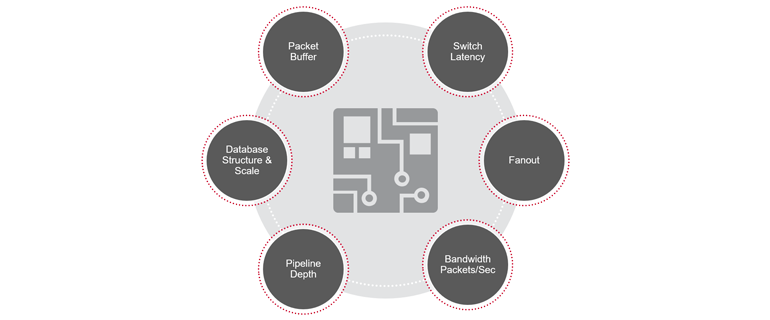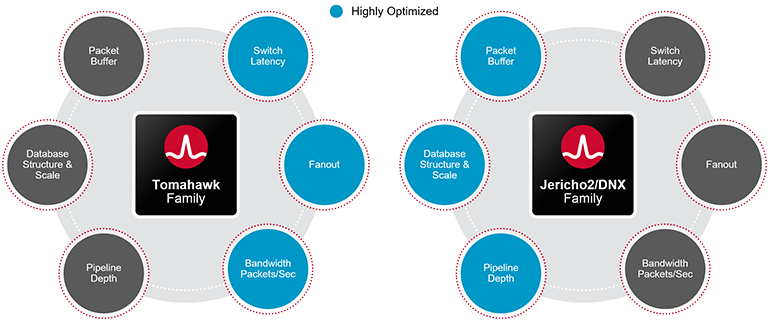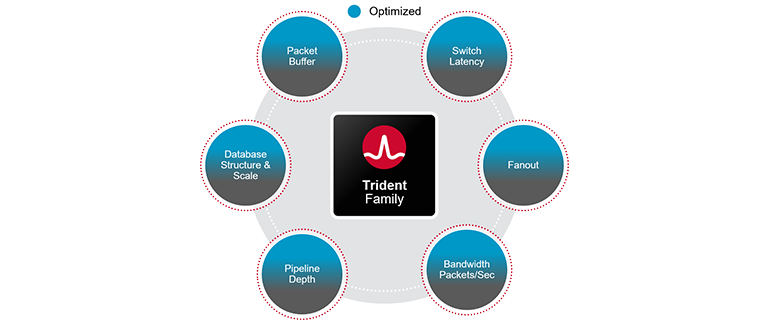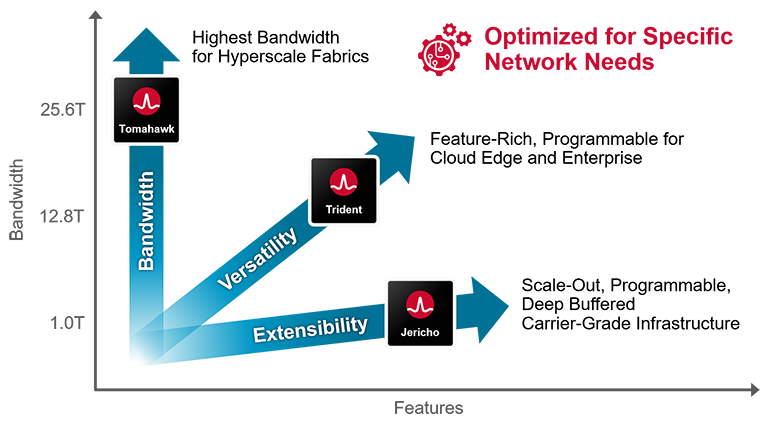The Latest Broadcom News
Product and Solution Information, Press Releases, Announcements
Domain-specific switch silicon in networking
April 13, 2020 By BlueAlly

Hennessey and Patterson argue in their article “A New Golden Age for Computer Architecture” that domain-specific architectures, as opposed to general purpose computing, are a viable path to improve performance and efficiency as they match applications to processor architecture. A similar analogy exists in networking infrastructure as we see three distinct market segments, Hyper-Scale Data Center, Service Provider and Enterprise with very different requirements. In designing switches and routers for network infrastructure, there are several dimensions to consider when optimizing for each segment.
Optimizing for all metrics simultaneously is not a matter of engineering capability but is rather a restriction imposed by silicon technology and economics. For example, optimizing for low latency requires decentralized databases rather than centralized databases. This is because accessing a centralized database would imply longer wires from different stages and therefore longer latency.

Figure 1: Key switch design dimensions
For Hyper-Scale Data Center network infrastructure, high bandwidth, switch radix, and latency are the most critical metrics since application bandwidth demands are rising much faster than other networking segments. Broadcom’s Tomahawk® family of switches are optimized to address the bandwidth challenges of the Hyper-Scale Data Center. Broadcom recently announced Tomahawk 4, the world’s first 25.6Tb/s switch for compute, storage and AI cluster connectivity.
In the Service Provider segment, the infrastructure is highly shared between various enterprises, consumers utilizing different applications over long distance transport. The Service Provider segment typically requires larger packet buffers, expandable tables, and rich features sets for edge and Internet peering applications.
Broadcom’s DNX line of processors are specifically optimized to address this segment. Broadcom’s Jericho 2, the industry’s leading packet processor for Service Provider applications, is now in full production. For chassis applications, Broadcom provides a Jericho 2 packet processor and an optimized fabric (Ramon) for chassis which typically results in overall power savings of ~25 percent compared to using the same silicon for packet processing and fabric forwarding. The Qumran line of DNX devices are very efficient to build fixed pizza boxes which high feature sets and capacity.

Figure 2: Tomahawk and Jericho2/DNX family optimizations
The Enterprise segment needs to address security/policy control to allow for mobility and to interconnect heterogeneous devices. In the Enterprise segment, while bandwidth is not growing as fast as other segments, a rich feature set with moderate packet buffer scale and table scales are required. For this segment, Broadcom’s Trident family addresses the need in terms of programmability and instrumentation. In 1H 2019, Broadcom announced Trident 4, the world’s first 12.8 Tb/s switch which is completely programmable with rich instrumentation capability.

Figure 3: Trident family optimizations
Broadcom continues to develop three distinct product lines to address the needs of customers. Features and scale that are necessary across all segments are developed and propagated across product lines (eg. Inband Telemetry). Features and scale specific to a segment that would impose a burden on a product in another segment are not propagated (eg. Service Activation Testing). Figure 4 below shows the three optimized switch product lines from Broadcom.

Figure 4: Broadcom switch product portfolio
Over the last decade, Broadcom has been optimizing silicon for each segment with market-leading scale, power efficiency, low latency, expandable buffers, expandable table scales, and a rich set of instrumentation capabilities. With a predictable roadmap for each of these segments, customers are building market leading platforms optimized for power, performance and efficiency.

